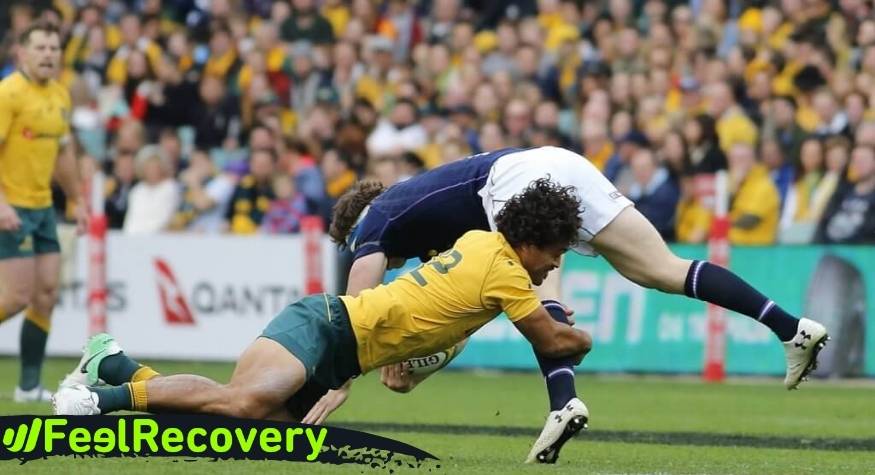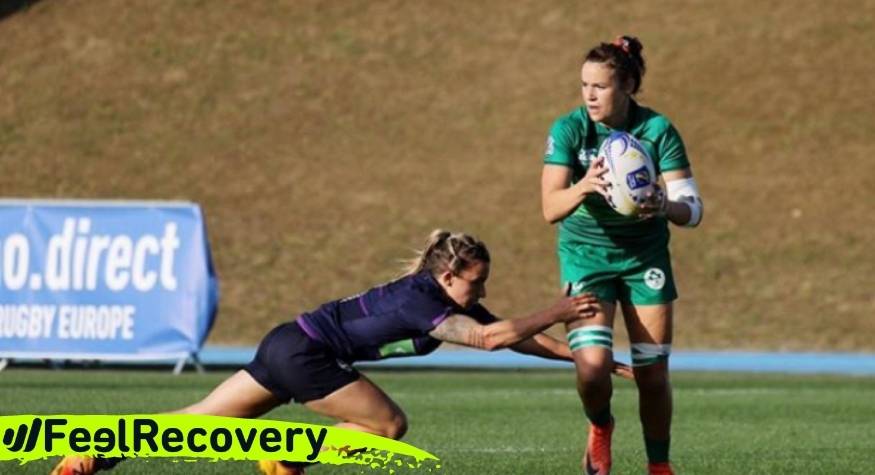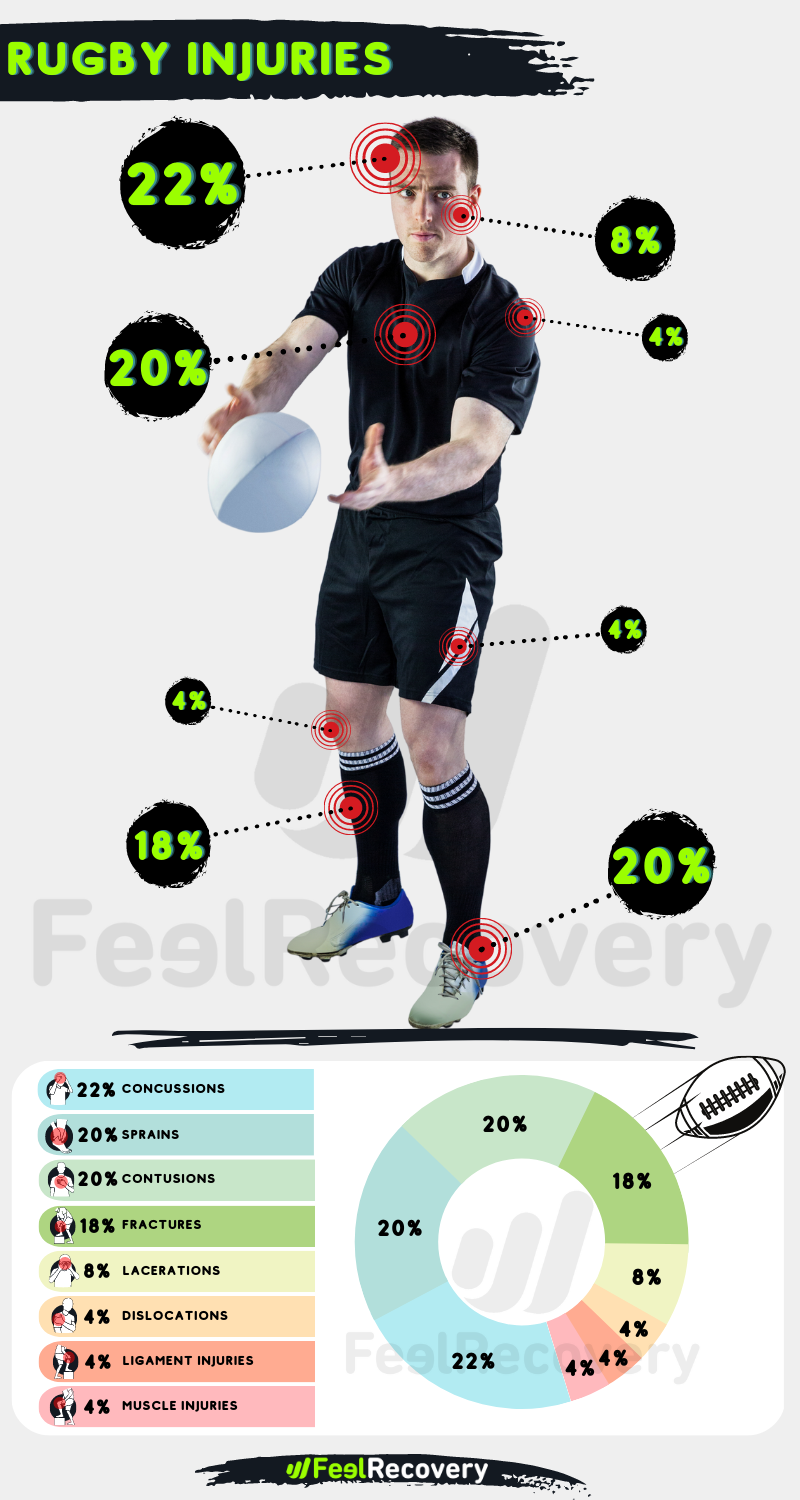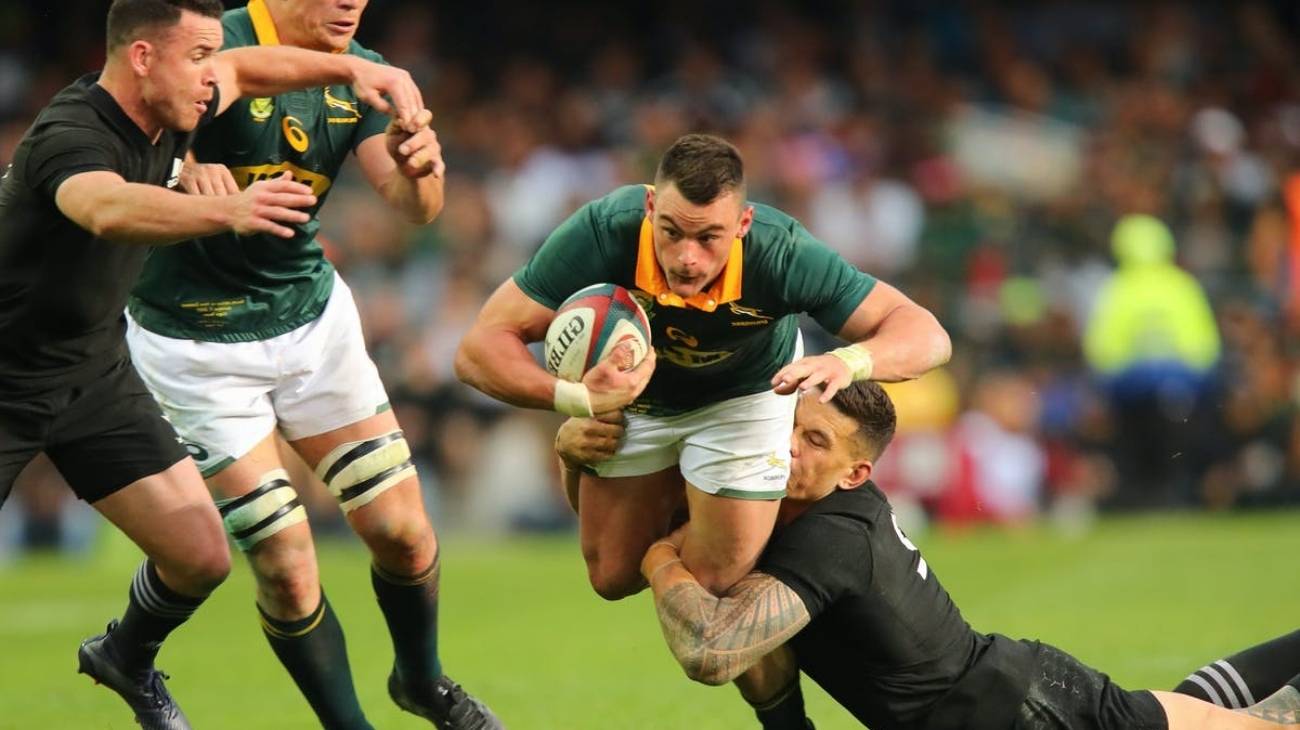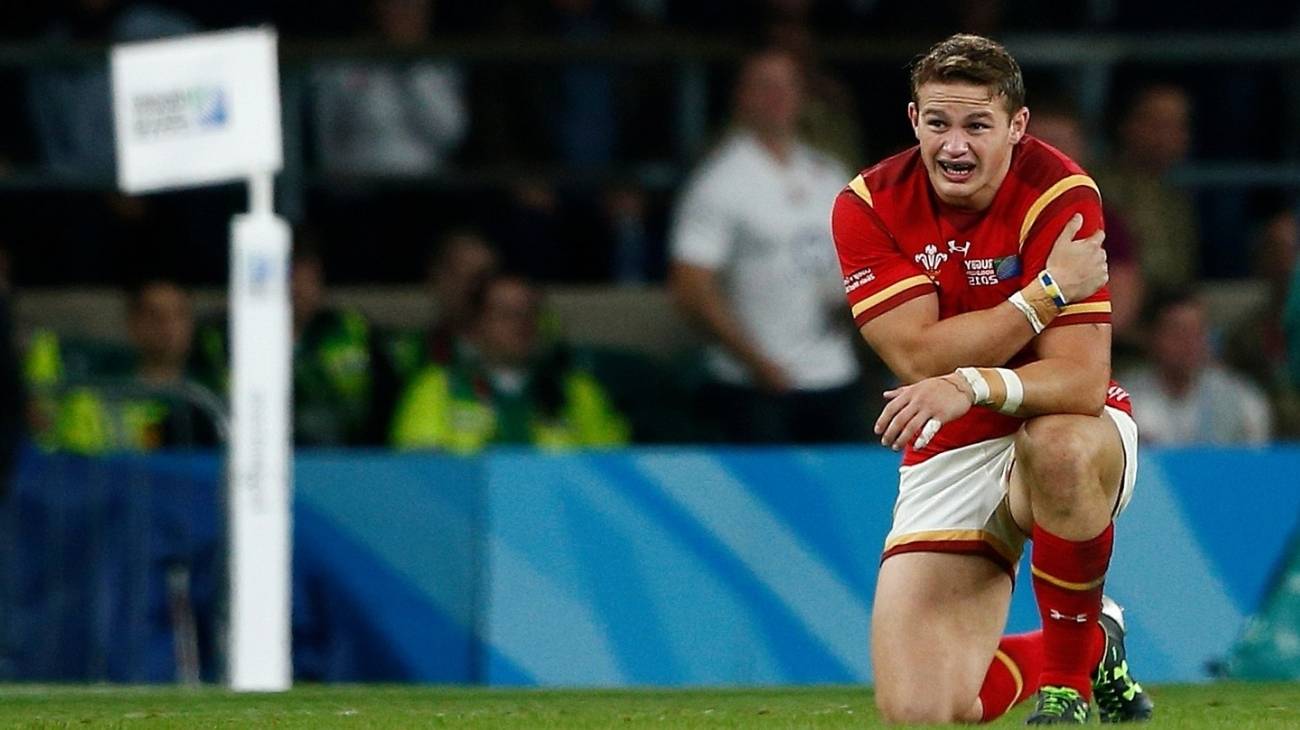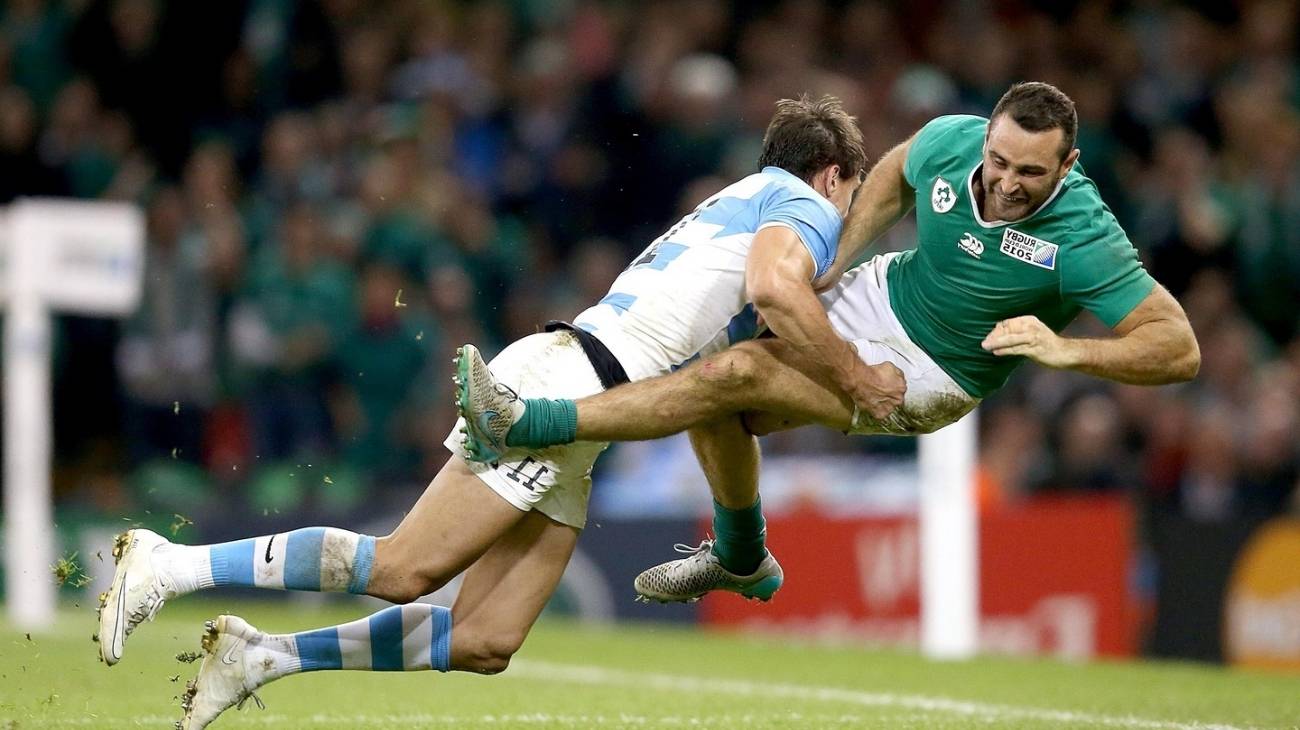Rugby is a sport that involves equal parts speed and strength in each of its movements. This combination of energies causes rugby players to suffer a variety of injuries in every training session or match, and these injuries can be serious.
It is important that both amateur and professional players are aware of the injuries to which they are prone. Therefore, we bring you this post to tell you what are the most common rugby injuries, how to prevent them and what is the most practical method to treat them, the RICE therapy. Join us to know them!
What are the most common types of injuries when playing rugby?
Most rugby injuries are closely related to direct contact between players during tackles. These injuries can vary according to the position of the player, with the legs being the most affected. However, to a lesser degree, upper limbs such as the neck and head can suffer trauma.
Overuse injuries such as tendonitis and bursitis are common. Also, traumatic injuries such as sprains, dislocations, fractures, among others. And, of the most delicate include concussions:
Concussion
This is the most delicate injury, although less frequent in rugby and its severity can range from mild, moderate to severe. It is the result of direct blows to the skull during falls or when contesting the ball. The impact of the blow causes internal trauma to the brain which can cause haemorrhaging and swelling.
The rugby player may be completely unconscious and knocked out by a concussion. However, this is not always the case; it can also present as a headache with dizziness, balance problems and memory impairment.
Head injuries
These injuries involve a group of facial, scalp, ear and nose injuries sustained when proper protection is not worn. They are generated by the forceful impact of movements in training or rugby matches.
Neck contractures
Neck injuries are common as players tend to hyperextend their necks in an effort to win the scrum. This can lead to shortening of muscle fibres which can be sustained over time and develop into a pathological contracture. In more serious cases, the contractures are often more severe, leading to partial tears of these muscles.
They are also a consequence of stress caused by overuse of the neck muscles. Symptoms of these injuries include pain of varying intensity and muscle stiffness.
Vertebral disc prolapse
This is a rather delicate injury and in general they tend to be extremely painful injuries. They are caused by high impact movements or too abrupt tackles. This causes the intervertebral discs to shift, resulting in pinching or compression of the spinal nerves. As well as causing severe pain, this can lead to neck swelling, hypersensitivity and stiffness.
Cervical vertebrae fractures
These are one of the most serious rugby injuries and should not be taken lightly. Rugby is a sport in which there are often awkward and uncomfortable falls that can result in fractures to the cervical spine. The high impact of these falls can lead to a breakage of the bones that make up the cervical spine.
The symptoms that this injury can cause include intense and extreme pain, inflammation, bruising, stiffness, instability and fragility of the neck. In the most serious cases, paralysis of the upper and lower limbs can occur.
Shoulder dislocations
This injury is also known as a dislocated shoulder and is one of the most common rugby injuries. The most common way it occurs is when the player holds his arm outwards during a fall. The sudden force of this movement causes a strain on the tendons and ligaments of the rotator cuff. This results in the humeral head pulling out of the glenoid cavity. This causes immediate severe pain, inability to move the arm and shoulder, and subsequent swelling.
Acromioclavicular joint sprain
This joint is part of the shoulder configuration, located on the outer anterior aspect of the shoulder. It is composed of the distal third of the clavicle and the acromion of the scapula. The sprain occurs following direct falls against the shoulder with the arm in extension.
This causes strain and damage to the ligaments, resulting in severe pain in the shoulder. Depending on the severity of the sprain, it is accompanied by limitation of movement, deformity and swelling.
SLAP injury
It is a very common injury among athletes who perform in disciplines that involve overhead movements. It is an injury to the labral fibrocartilage surrounding the glenoid socket. The main cause is direct trauma and overuse of the joint. It is also closely related to previous rotator cuff injuries. Depending on the degree, it can lead to non-specific shoulder pain, stiffness, instability, weakness and clicking.
Clavicle fracture
Usually due to direct falls onto the shoulder during the power movements of rugby. Loss of bone strength and subsequent breakage is common due to the high impact of falls on the shoulder. This causes the bone to move out of position, increase in volume, inability to move the shoulder and severe pain.
Hand, wrist and finger fractures
The bones of the hand are very susceptible to fractures during rugby. They are usually caused by direct high intensity trauma and impact, resulting in broken bones in the hand. This is because the bones in this area are more fragile and thinner than elsewhere in the body.
Any fracture at the level of the bones in the hand causes intense pain that can be made worse by moving or squeezing the hand. It also causes swelling, hypersensitivity, deformity, numbness, stiffness and in some cases bruising.
Patellar tendonitis
It presents as an inflammation of the tendon that joins the patella and tibia bones, the so-called patellar tendon. It is an overuse injury where micro-tears can occur. This injury is due to the high impact of running at high speed with sudden stops and high jumps when playing.
Initially the player may describe mild pain in the knee, but it worsens as the days go by. Subsequently, their sporting activity and often daily life is affected. The pain is accompanied by stiffness, swelling, hypersensitivity, and weakness in the leg.
Meniscal tear
This is a very common injury in rugby players and is caused by overloading the joint. It occurs when running with sudden twisting or rotating movements of the knee. The effect of these movements causes degeneration, rupture and tearing of the meniscus. The symptoms manifest themselves over time, with the pain increasing over the weeks. The pain in advanced stages is usually severe, accompanied by oedema and stiffness of the knee.
Anterior cruciate ligament injury
This is the most feared injury for rugby players because it has a tendency to lead to disability. It consists of a partial or complete tear of the anterior cruciate ligament, considered one of the most important ligaments of the knee joint.
It occurs when players stop suddenly and abruptly after running at speed. In addition, it is often influenced by jumping and landing with the feet or sudden changes of direction. The characteristic sign is a loud popping sound, intense pain, rapid increase in volume, and instability of the knee.
Ankle sprain
One of the most common injuries in rugby players. It is characterised by a strain or tear in the ligaments that make up the ankle joint. It usually occurs in sudden movements where the ankle is twisted inwards or outwards.
In addition to the tearing of the ligaments, the joint capsule and blood vessels may rupture, causing tissue haemorrhage. Ankle sprains cause moderate pain, swelling and limited movement of the foot. In severe cases, it is accompanied by joint instability, bruising and clicking.
Best products for rugby injury recovery
Bestseller
-
2 Knee Compression Sleeve (Black/Gray)
£20,95 -
2 Knee Compression Sleeve (Green/Navy)
£20,95 -
2 Knee Compression Sleeve (Pink/Bordeaux)
£20,95 -
2 Thigh Compression Sleeve (Green/Navy)
£20,95 -
2 Thigh Compression Sleeve (Pink/Bordeaux)
£20,95 -
Gel Eye Mask for Puffy Eyes (Gold/Black)
£9,95 -
Gel Eye Mask for Puffy Eyes (Orange/Pink)
£9,95 -
Gel Eye Mask for Puffy Eyes (Purple/Turquoise)
£9,95 -
Microwave Wheat Bag for Back Pain Relief (Extra Large) (Hearts)
£24,95 -
Microwave Wheat Bag for Back Pain Relief (Extra Large) (Oxford)
£24,95 -
Microwave Wheat Bag for Back Pain Relief (Extra Large) (Sport)
£24,95 -
Microwave Wheat Bag for Neck & Shoulder Pain Relief (Hearts)
£24,95 -
Microwave Wheat Bag for Neck & Shoulder Pain Relief (Oxford)
£24,95 -
Microwave Wheat Bag for Neck & Shoulder Pain Relief (Sport)
£24,95 -
Microwave Wheat Bag for Neck Pain Relief (Hearts)
£20,95 -
Microwave Wheat Bag for Neck Pain Relief (Oxford)
£20,95 -
Microwave Wheat Bag for Neck Pain Relief (Sport)
£20,95
-
2 Calf Compression Sleeve (Black/Gray)
£20,95 -
2 Calf Compression Sleeve (Green/Navy)
£20,95 -
2 Calf Compression Sleeve (Pink/Bordeaux)
£20,95 -
2 Thigh Compression Sleeve (Black/Gray)
£20,95 -
Back Support Belt (Black)
£39,95 -
Back Support Belt (Green)
£39,95 -
Back Support Belt (Pink)
£39,95 -
Foot Massage Roller for Plantar Fasciitis (Black)
£20,95 -
Foot Massage Roller for Plantar Fasciitis (Green)
£20,95 -
Foot Massage Roller for Plantar Fasciitis (Pink)
£20,95 -
Ice Massage Roller Ball (Black)
£34,95 -
Ice Massage Roller Ball (Green)
£34,95 -
Ice Massage Roller Ball (Pink)
£34,95 -
Shoulder Support Brace (Black)
£24,95 -
Shoulder Support Brace (Green)
£24,95 -
Shoulder Support Brace (Pink)
£24,95 -
Soft Density Foam Roller for Recovery (Black)
£34,95 -
Soft Density Foam Roller for Recovery (Green)
£34,95 -
Soft Density Foam Roller for Recovery (Pink)
£34,95
How to prevent injuries when playing rugby?
The main injuries in rugby are due to lack of muscular conditioning, poor technique and accidents on the field. For this reason, it is necessary to take certain preventive measures that allow you to enjoy the practice of this great sport without running risks. These are the necessary preventive measures for playing rugby:
Warm-up
The warm-up comprises a series of movements and exercises that help the body to condition itself for physical activity. It comprises different phases of progressive intensity to restore the mobility of muscles and joints and thus prevent injuries. It is important that it is carried out for 15 to 20 minutes, which is enough time to complete these exercises.
These are the phases of the warm-up:
- Gentle exercises: You should start with a series of gentle exercises that work each of the muscle groups and joints. This starts the activation of the peripheral nervous system and the muscular and articular system. It also serves as a mental preparation for the sports session.
- Stretching: The stretching stage is also very important in the warm-up as it improves the flexibility of muscles and soft tissues. Stretching improves muscle tension and prevents muscle contractures and tears.
- Resistance exercises: Resistance exercises increase blood flow to all muscle groups and other tissues. This leads to greater coordination, agility and strength. It also increases lung capacity to improve physical capacity and endurance.
Cool down
Because rugby is a physically demanding sport, causing inflammation and pain, a cool-down phase is necessary. It represents a cool down phase and should therefore be gradual to aid physical and mental recovery. Its main objectives are to reduce heart rate, breathing and muscle tone to normal values.
It comprises two very important stages:
- Gentle walking: After rugby practice, a gentle walk around the pitch should be undertaken. This can be combined with lower limb raises and deep breathing. This ensures a gradual stop and a proper recovery of muscles and joints.
- Stretching: Stretching is especially important because it prevents future injuries. In rugby it is important to focus on the muscles of the upper and lower limbs. At this stage, tone reduction, relaxation and lengthening of the muscles are achieved.
Equipment
In rugby it is necessary to take the necessary measures to ensure that the environment is suited to the needs of the players. It is therefore necessary for each player to have the following equipment:
- Equipment: This is clothing that serves to reduce minor injuries, cuts, bruises or abrasions. They are also especially useful in contact situations. This padded equipment must be worn underneath the clothing and must be approved by World Rugby.
- Footwear: Footwear is a very essential part of rugby practice and training. They must be suitable for the surface of the field and be in the best condition. In general they should meet World Rugby specifications.
- Mouthguard: Mouthguards are an indispensable item and are used to reduce the force of impacts to the dental area. It also prevents injuries and fractures to the lower jaw and injuries to the gums, lips and tongue.
- Head protection: Although rugby does not allow the use of helmets as in American football, it is possible to use a kind of head protector made of padded, impact-resistant material, which also protects the ears and forehead.
Nutrition and hydration
Nutrition in rugby is essential as a sport of strength, speed and skill requires adequate sources of energy. Nutritional requirements ensure adequate performance in matches. It also provides energy to the muscles in motion and activates the cognitive functions of the player.
Under normal conditions rugby players must strive to maintain an increased muscle mass. They therefore have very specific energy requirements in terms of quantity, type and distribution of carbohydrates. This is because during matches players deplete their glycogen stores.
The intake of carbohydrate-rich foods should be adapted to the training schedule. They should be consumed every 3-4 hours, accumulating approximately 3500-5000 calories during the day. They can be distributed as follows:
- Pre-match nutrition: It is important to have a meal 3 hours before the match that contains a good load of complex carbohydrates. A small portion of lean protein should be included, not including fibre.
- Food during matches: During breaks or in the locker room, the diet should be reinforced with energy bars and fruit. The idea is to keep energy levels high so that players maintain the expected performance.
- Post-match nutrition: To help with recovery, energy recovery shakes, sandwiches with complex carbohydrates and lean meats should be added. After 1-2 hours a meal should be taken to supplement protein repair and glycogen recovery.
Proper hydration during matches should be provided by sports drinks. These contain adequate amounts of glucose, sodium and potassium to ensure immediate replenishment of depleted reserves.
Also, during and after matches, there must be good hydration so that the cells of our organism work properly. In this way, muscle injuries such as tears and contractures can be avoided.
Fitness
Fitness in rugby is of vital importance when training or playing in matches. The physical condition of the players must guarantee the performance of agile and highly efficient technical gestures. As a main characteristic, strength must be highlighted in order to be able to perform physical contact movements.
Endurance, speed, agility and flexibility are required, which the player must know how to use depending on the position he/she is playing. For this reason, rugby players must have adequate training to help them develop each of these qualities.
It must be taken into account that rugby matches last 80 minutes and are very physically intense. A good player must be able to withstand all this time with the same endurance and capabilities without getting injured.
Recovery therapies
Recovery therapies are the most effective methods of maintaining and enhancing the performance of rugby players. They can reduce fatigue, pain, inflammation and improve physical condition. These are the most commonly used at present:
- Sports massage: This technique is one of the most effective methods of improving player performance and preventing injury. It is specially designed to rehabilitate muscles and improve players' working capacities. It has proven to be highly effective in top-level sportsmen and women, especially in guaranteeing adequate physical health.
- Use of hot and cold therapies: Hot and cold contrast therapy has been proven for many years to promote physical recovery after intense training. It is effective in reducing muscle fatigue and pain considerably and thus prevents muscle contractures.
- Use of compression clothing: Wearing compression garments for at least 5 days considerably reduces loss of strength, swelling, pain and stiffness. They are an effective recovery therapy if used immediately after an injury because they positively restore muscle condition.
- Use of acupressure therapies: Acupressure is based on applying pressure with the fingers at certain points where energy is released. Injuries are considered misalignments or blockages in that energy, so acupressure helps considerably to improve them. In addition, it also stimulates energy to improve the supply of oxygen which results in relaxation and improved vitality.
- Use of thermotherapy and cryotherapy: Thermotherapy and cryotherapy are two very effective recovery techniques during rugby. Thermotherapy offers relaxation of muscles, tendons, ligaments and joints. Cryotherapy, on the other hand, offers a faster recovery process by reducing pain and inflammation.
How to apply the RICE therapy to treat first aid injuries in rugby?
Injuries to joints, soft tissue and muscles are best treated with the RICE therapy. The RICE therapy comprises a series of first aid steps that are well known and used by sportsmen and women. It has been updated to the PRICE therapy a few years ago because it has proven to be more effective. The PRICE therapy owes its name to the acronym for: Protection, Rest, Ice, Compression and Elevation.
In rugby injuries we can use it in the following way:
- Protection: In the event of any injury, the player and the injured area should be protected to prevent complications or further injury. Joints should be secured with elastic bandages, straps, orthoses or supports to prevent the injured area from being strained.
- Rest: Rest involves the relative cessation of function of the injured part. This phase is necessary to ensure healing and repair of the tissues by avoiding stress and putting weight on the area. This rest should not exceed 48 hours to avoid stiffness in the injured parts.
- Ice: Applying ice is another indispensable technique when injuries occur during rugby sports practice. Ice reduces the risk of bleeding, swelling and pain. Ice packs or gel packs should be used for 20 minutes every 2 hours for the first 72 hours.
- Compression: Compression is necessary to prevent oedema, swelling and pain in the injured area. An elastic bandage should be used, which will also be very helpful in shortening tissue recovery time. It is important to make sure that the bandage is not too tight to avoid reducing blood circulation.
- Elevation: As a complement to the other techniques, the injured area should be kept about 30 cm above the level of the heart. This helps to improve venous return and therefore swelling, oedema and pain.
When should we see a medical specialist for the treatment of injuries in rugby players?
As mentioned above, rugby is a game that involves a lot of strength and it is common to generate many serious acute injuries. Most can be easily resolved, however, these signs indicate that a specialist should be consulted:
- Active bleeding: Any injury that bleeds uncontrollably should be evaluated by a specialist. This is very important, especially if the bleeding does not respond to basic first aid measures.
- Loss of consciousness: When head injuries occur and there is a sudden loss of consciousness, medical evaluation is necessary. This could be a severe traumatic brain injury.
- Confusion and memory loss: Rugby players sometimes continue to play after head injuries. In the presence of confusion, memory loss, dizziness, blurred vision, a medical specialist should be consulted.
- Fractures with bone exposure: Fractures of the hands, wrists, fingers and ankles that expose bone is an emergency and should be evaluated by a specialist.
Other injuries that are not life-threatening, but which in the long term can affect the performance of any athlete require assessment. The most common are as follows:
- Recurrent joint pain: Attention should be paid to morning joint pain that worsens with the performance of daily activities. Also joint pain that lasts for a long time and prevents sleep.
- Persistent swelling: The presence of progressive joint enlargement is also a very important pathological sign. Less severe lesions only generate local and transitory increases in volume, while severe lesions tend to persist.
- Stiffness and limitation of movement: It is important to pay attention to any stiffness or functional limitation of any injured joint or part. This would indicate a more serious injury to ligaments and tendons.
References
- Kaplan, K. M., Goodwillie, A., Strauss, E. J., & Rosen, J. E. (2008). Rugby injuries. Bulletin of the NYU hospital for joint diseases, 66(2), 86-93. https://www.safetylit.org/citations/index.php?fuseaction=citations.viewdetails&citationIds[]=citjournalarticle_88090_11
- Freitag, A., Kirkwood, G., Scharer, S., Ofori-Asenso, R., & Pollock, A. M. (2015). Systematic review of rugby injuries in children and adolescents under 21 years. British journal of sports medicine, 49(8), 511-519. https://bjsm.bmj.com/content/49/8/511.short
- Bottini, E., Poggi, E. J. T., Luzuriaga, F., & Secin, F. P. (2000). Incidence and nature of the most common rugby injuries sustained in Argentina (1991–1997). British Journal of Sports Medicine, 34(2), 94-97. https://bjsm.bmj.com/content/34/2/94.short
- Gibbs, N. (1994). Common rugby league injuries: recommendations for treatment and preventative measures. Sports Medicine, 18, 438-450. https://link.springer.com/article/10.2165/00007256-199418060-00007
- Carson, J. D., Roberts, M. A., & White, A. L. (1999). The epidemiology of women's rugby injuries. Clinical Journal of Sport Medicine, 9(2), 75-78. https://journals.lww.com/cjsportsmed/abstract/1999/04000/the_epidemiology_of_women_s_rugby_injuries.6.aspx
- Quarrie, K. L., & Hopkins, W. G. (2008). Tackle injuries in professional rugby union. The American journal of sports medicine, 36(9), 1705-1716. https://journals.sagepub.com/doi/abs/10.1177/0363546508316768
- Quarrie, K. L., Cantu, R. C., & Chalmers, D. J. (2002). Rugby union injuries to the cervical spine and spinal cord. Sports Medicine, 32, 633-653. https://link.springer.com/article/10.2165/00007256-200232100-00003
- Brooks, J. H., Fuller, C. W., Kemp, S. P., & Reddin, D. B. (2006). Incidence, risk, and prevention of hamstring muscle injuries in professional rugby union. The American journal of sports medicine, 34(8), 1297-1306. https://journals.sagepub.com/doi/abs/10.1177/0363546505286022
- Silver, J. R., & Stewart, D. (1994). The prevention of spinal injuries in rugby football. Spinal Cord, 32(7), 442-453. https://www.nature.com/articles/sc199471
- Newton, D., England, M., Doll, H., & Gardner, B. P. (2011). The case for early treatment of dislocations of the cervical spine with cord involvement sustained playing rugby. The Journal of Bone and Joint Surgery. British volume, 93(12), 1646-1652. https://boneandjoint.org.uk/article/10.1302/0301-620X.93B12.27048



















































































